If the home is where the heart is, then it’s best adorned with charming, colorful, and alluring succulents that can help each day become bright, cheerful, and stress-free.
And it’s not just their aesthetic appeal that makes succulents a favorite among plant hobbyists.
Succulents are easy to grow and care for. These are no-fuss varieties of flora that are resilient and durable enough to survive harsh conditions.
Why Succulents Make Perfect Indoor Plants
If you live a busy lifestyle, you don’t have to worry about watering your succulents. Succulents store water in their stems and leaves which allows them to tolerate long periods of drought and tough desert conditions.
Unlike other species of plants, succulents should only be given water when their soil has gone completely dry. Giving the soil water while it still retains moisture can lead to root rot and kill your succulent.
To further protect your indoor succulent from the threat of root rot, plant it in a pot made of unglazed ceramic or terracotta which absorbs moisture quickly from the soil. Make sure the pot has a drain hole to filter out excess water.
For your choice of soil, go for sandy soil or a commercial succulent blend with added materials such as pumice, perlite, coarse sand, and lava rocks to improve drainage.
As an indoor plant, you only have to make sure that your succulents get at least 6 hours of partial to full sunlight every day. If you don’t have a window that brings in enough sunlight, place your succulent under a Grow Light.
6 Best Indoor Succulents
There are hundreds of varieties of succulents to choose from. You could get lost in a nursery looking for the right species that fit your tastes and sensibilities. We’ve made shopping easier for you by coming up with our list of the best indoor succulents for your home.
1. Graptopetalum Paraguayense
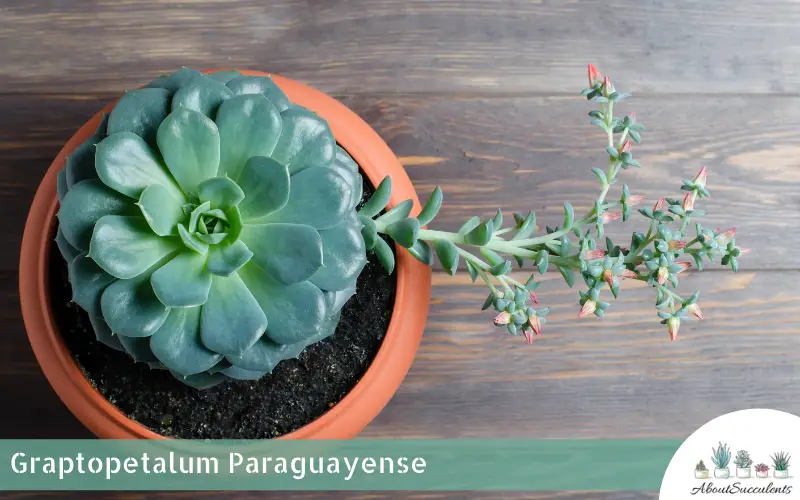
Graptopetalum paraguayense is the perfect succulent for your home if you experience winter as ‘Ghost Plant’ is cold-hardy and can tolerate frosty weather.
With its fleshy, grayish-white colored, opalescent, ghost-like leaves, having Graptopetalum paraguayense inside your home can be a quick, conversation starter among your guests.
The succulent is native to Mexico and doesn’t grow more than 1 foot (30.48 cm) in height and occupies only 3 feet (91.44 cm) of space. In the springtime, look out for small, star-shaped, and yellow-colored flowers.
If your guests are thrilled with Ghost Plant, you’ll be glad to know that it produces offsets or pups that you can use for propagation so you can give them as gifts to your friends.
2. Lithops
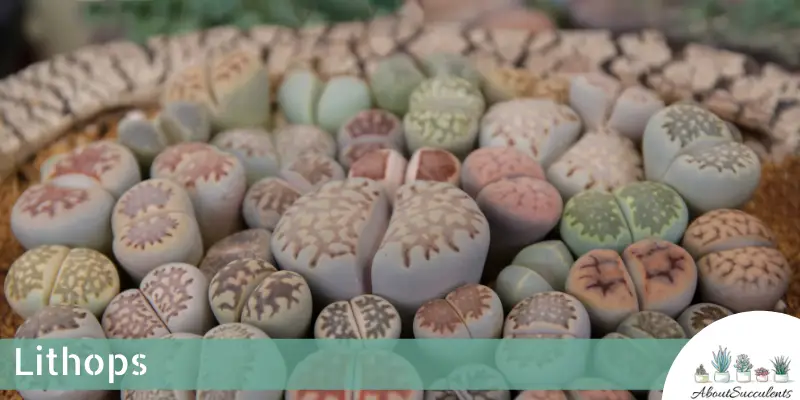
Lithops is native to South Africa and is a genus of succulent plants that resemble stones or pebbles. What looks like rocks are actually 2 fused plump leaves that have a slit between them.
Come springtime, leaves will sprout forth from this slit, and in the late summer or fall months, expect to see yellow or white-colored flowers that look like daisies.
There are close to 150 varieties and nearly 40 species of “Living Stones” or “Pebble Plant” to choose from. Each “stone” looks unique with its own set of shapes, markings, and color combinations that range from pink, rust, brown, and grey.
Lithops would make an interesting conversation piece in your home. Some of your friends might argue that your plants look more like split brains than living stones!
3. Aeonium Arboreum ‘Zwartkop’
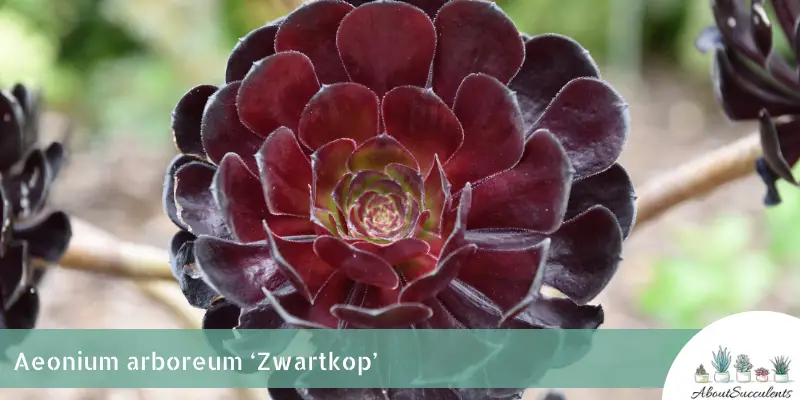
One reason why you should have Aeonium arboreum ‘Zwartkop’ in your home is that this succulent won the distinguished Award of Garden Merit from the Royal Horticultural Society.
Zwartkop can grow up to 4 feet (120 cm) in height and spread 2 feet (60 cm) wide. With its mysterious-looking, fleshy, dark-burgundy colored leaves, Zwartkop can add height and contrast to any minimalist living space with predominantly white-colored walls.
Being an Aeonium, Zwartkop is a monocarpic succulent and will die after producing flowers. However, it might take several years before the plant blooms. Zwartkop’s small, star-shaped, and yellow-colored flowers come out in the springtime.
4. Echeveria runyonii ‘Topsy Turvy’
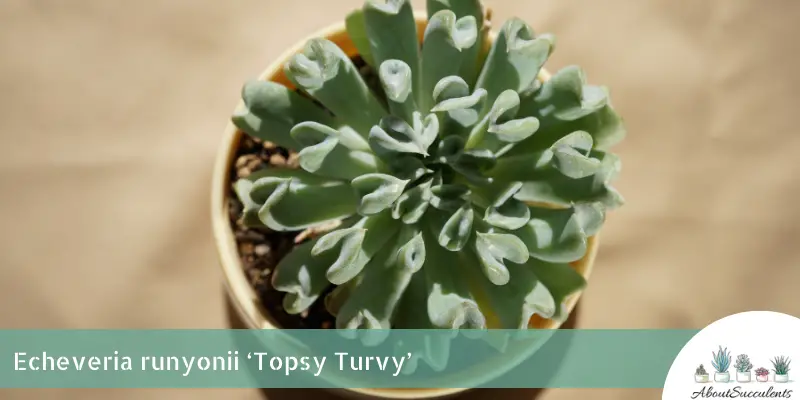
Add Echeveria runyonii ‘Topsy Turvy’ to your collection of award-winning indoor succulents.
Topsy Turvy won 2 prestigious awards – the Award of Garden Merit from the Royal Horticultural Society and Garden Path magazine’s October 2010 “Plant of the Month”.
Native to Mexico, this lovely evergreen succulent got its nickname because of its elegant, grayish-powder blue leaves that turn, spiral downward and form delicate rosettes.
Echeveria runyonii ‘Topsy Turvy’ can reach a height of 12 inches (30.48 cm) indoors. Sometime in the late summer or fall months, Echeveria will produce star-shaped flowers that range in color from yellow to orange.
5. Aloe 'Doran Schwarz'
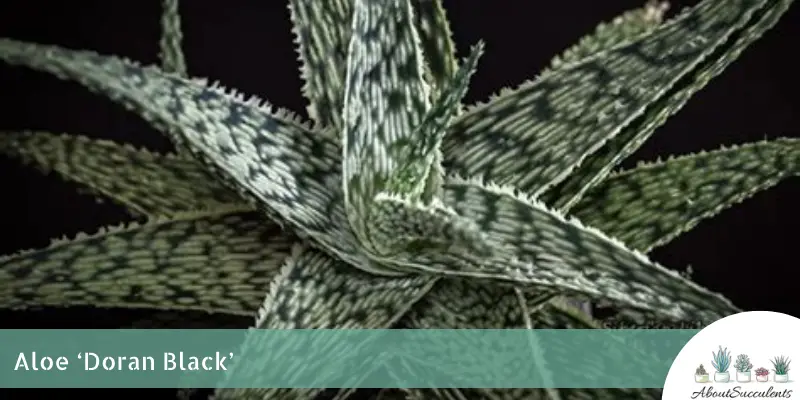
Aloe is a genus of succulents that remains a popular choice of horticulturists looking to adorn their homes with plants. ‘Doran Black’ is a variety of Aloe that will undoubtedly create interesting conversation among your house guests.
Aloe ‘Doran Black’ is characterized by its dark green leaves that are accented with thick, white-colored bumps, and jagged margins. If you position Doran Black in a place that gets a lot of sunlight or under a Grow Light for 6 hours per day, the dark green colored leaves will assume a copper hue.
Doran Black produces offsets near its base. You can pull out the matured offsets for propagation. The great thing about having this peculiar-looking succulent in your home is that it can produce bell-shaped, yellow to orange-colored flowers year-round if properly cared for.
6. Kalanchoe beharensis ‘Fang’
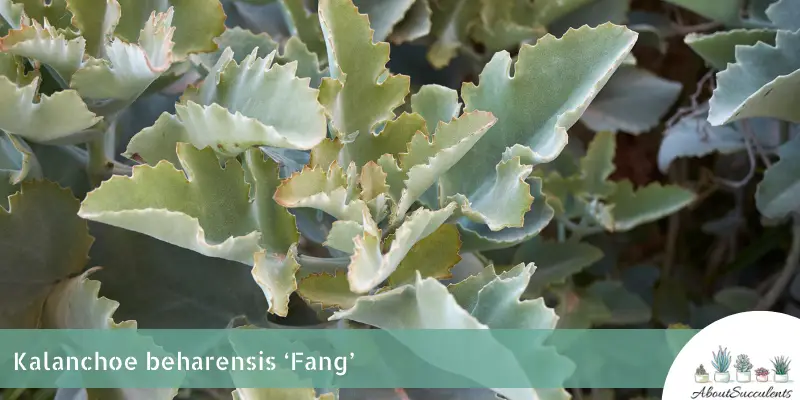
Kalanchoe beharensis ‘Fang’ goes by multiple interesting nicknames such as ‘Felt Plant’, ‘Felt Bush’, ‘Stalactite Plant Fang’, and ‘Velvet Leaf Kalanchoe’.
These names are borne out of this variety of Kalanchoe’s odd, weirdly-beautiful appearance that’s identified by its thick, triangular-shaped leaves that are colored bronze on the surface and silver-gray underneath.
The leaves are covered by fine silver hairs and triangular protrusions that give the impression of the foliage having fangs.
Another interesting feature of Felt Plant is its floral blooms – clusters of small, urn-shaped flowers that are colored red-orange or yellow-green. Fang will bloom when it matures, often in the late summer or early fall months.
However, Fang remains sought-after for its gnarly foliage. Similar to ‘Zwartkop’ and ‘Topsy Turvy’, ‘Fang’ is also a recipient of the prestigious Award of Garden Merit from the Royal Horticulture Society.
Schlussfolgerung
Whether succulents are used indoors to adorn a room in a simple bungalow or as a natural sunshade in a US$50-million home in Monaco, these plants add life to any living space.
If you live in a part of the world where temperatures can drop below freezing, succulents become the perfect indoor plant to turn your home warm and cozy.
As long as your succulent plant gets a lot of morning sunshine every day and water whenever its soil has completely dried out, it will remain healthy and happy for several years.
Last Updated on Dezember 20, 2022 by Sofia Lara